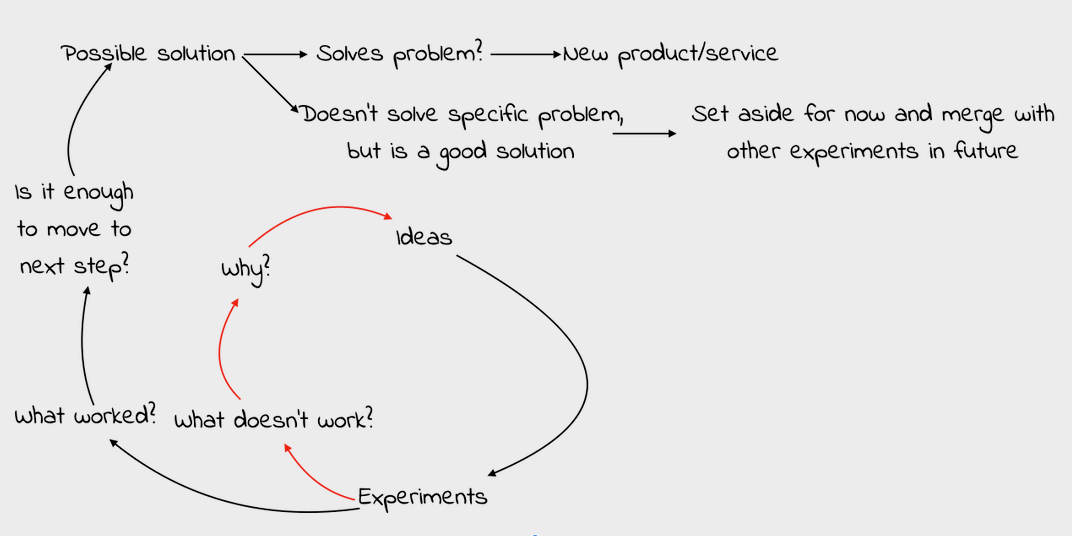In his book, The Rational Optimist: How Prosperity Evolves, Matt Ridley draws similarities between the evolution of biological novelty and technological novelty. He focuses on the point that just as recombination of genetic sequences as a result of sex leads to biological novelty, the recombination of ideas resulting from trade leads to technological novelty. Innovation tends to happen when a bit of luck is involved, which is why liberal economies that indulge in enthusiastic free trade tend to do well.
Innovation is not a linear sequence of events executed according to a plan that leads to a new product or service. The purpose of a good strategic plan is to have insurance against future moodiness and inconsistencies. Innovation often happens unplanned, when you can think of all the random thoughts under your domain of expertise and then start experimenting to see if the ideas can turn into practical solutions. As you can see in the picture below, each idea experiment leads to three things:
- More ideas due to failed experiments
- Possible solutions that don't solve a problem on hand, but are great for solving future problems
- Solution to solve an existing problem, in other words birth of a new product/service

The more you brainstorm ideas and experiment, the closer you are to being innovative. The process must happen at enormous speed, so you have a series of dots (failures) that don't connect yet, but are ready to be lined up if you need them for a future solution.
Google allows its employees to spend 20 percent of their time each week to work on projects that will help the company. For more than 70 years, 3M's unique 15 percent culture allows employees to experiment on ideas, test new technology, or find a new way to run a process.
When a company is experimenting on new ideas and goes a step further to patent them, it is more complex and expensive for their rivals to play in the same field. As an entrepreneur, this is frustrating because the original intent of patents is to share ideas with other creators and treat ideas with open knowledge. When companies go too far into intellectual property law to defend their monopoly, it blocks other innovations that intend to follow the same path but achieve a different goal.
Human beings have an inherent tendency to seek out novelty and challenges, extend and exercise their capacities, explore, and learn. In Daniel Pink's book Drive: The Surprising Truth About What Motivates Us, he describes two types of tasks that occur in our workplace:
- Algorithmic task-follow a set of instructions down a single path to a conclusion
- Heuristic task- experiment with possibilities and devise a novel solution
A study conducted by McKinsey and Co. estimated that, on average, 30% of job growth from algorithmic work, while 70% comes from heuristic work. The reason- routine work can be outsourced or automated; artistic, empathic, nonroutine tasks cannot. Algorithmic tasks are easier to copy if you have access to the process knowledge. Algorithmic assignments are also clearly defined in process and policy documents. Thus, if the company can train an employee on the algorithmic task, it can also replace the employee by leveraging technology or outsourcing the work. On the other hand, heuristic tasks are harder to mimic because they include a surprise element of 'tacit knowledge.' Tacit knowledge is nothing but an archive of aha moments which usually never gets documented on paper or a patent.
The process of innovation requires a balance of analytical thinking- breaking down a process and understanding how each part contributes to the whole, and creative thinking- brainstorming ideas to solve a problem and freely experimenting to see which works best. A person cannot do both at the same time. Because an individual usually has a dominant way of thinking, it is challenging to get both the analytical and creative types to work within the same group.
The IDEA model to improve the outcomes and think creatively has four stages:
- Ideate- create a list of all ideas possible, regardless of how crazy they sound at first.
- Drain- step away from the problem and allow your subconscious mind to think and filter through the thoughts.
- Elucidate- return to the problem and discuss feedback since the last meeting. Add, modify, combine or delete actions on the list.
- Apply- test out and verify the feasibility of best ideas.


